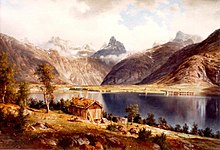Johan Fredrik Eckersberg

Johan Fredrik Eckersberg (born June 16, 1822 in Drammen , † July 13, 1870 in Bærum ) was a Norwegian painter of national romanticism and the Düsseldorf School of Painting .
Life
His parents were the merchant Knud Eckersberg (* 1792) and his wife Marie Cathrine Rude (* 1795). On October 2, 1850, he married Laura Martine Hansen (* December 27, 1821 - March 23, 1878), daughter of the sutler Lars Hansen and his wife Anne Karine Bodin.
Eckersberg was to become a businessman like his father. Instead, he became a major artist in the transition from Romanticism to Realism.
He was not a good student and was sent to the Netherlands at the age of 16 to learn the commercial language of the time. During a visit to Amsterdam he came into contact with painting. He was immediately enthusiastic, got himself the painting utensils and began to copy the old masters. In 1841 his father called him home to work for his agency in Christiania. Outside of his working hours he continued drawing and painting, came to the Royal School of Drawing in 1843 and became a student of Johannes Flintoe . In the summer of 1846 he was allowed to accompany Hans Gude and August Cappelen on a trip to Gudbrandsdal . This study trip was of great importance for Norwegian landscape painting. The high mountain motifs thus became a fixed romantic theme.
In the same autumn he received a state scholarship for two years and moved to Düsseldorf , where he was a student of Johann Wilhelm Schirmer at the Art Academy in 1847/1848 . The sober Eckersberg did not like his theories, and after two years he returned. From 1848 he lived in Christiania, apart from a two-year stay from 1852 to 1854 on Madeira because of his tuberculosis, and half a year in Düsseldorf. As a member of the circle around Peter Christen Asbjørnsen , he became one of the best fairy tale illustrators. From 1850 to 1851 he provided a number of drawings for Asbjørnsen's collection of folk and children's fairy tales. In Madeira, he created Views in the Islands of Madeira , a series of lithographs that did not bring the hoped-for financial success. From 1854 to 1856 he worked again in Düsseldorf. His family returned home likely due to poor health. His economic situation was bad. He has now returned to Norway as well. There was no training center for painters in Norway. The royal academy was not enough. In 1859, despite his tuberculosis, he founded a painting school in Christiania. From 1863 the school received a state grant. Many famous painters were his students, for example Gerhard Munthe and Christian Skredsvig .
In 1850 he became a member of "Det Norske Kunstakademi", which was the director of the drawing school. He was also a member of the management of the National Gallery and, from 1864, of “Christiania Kunstforening”.
Eckersberg lived in the heyday of Norwegian romanticism. While other painters of the time mainly painted effective high mountain motifs, he also took on open landscapes of Eastern Norway. His paintings are characterized by great attention to detail without painterly effects. He hardly let imagination come to fruition, but rather sobriety and refrained from artificially exaggerating the natural motifs. In this way he had a great influence on his students and is considered a pioneer of realism in landscape painting. He painted his most important pictures in the 1860s, such as the View from Valle im Setesdal (1852), which is one of his most demanding works and is committed to the large-scale landscape composition in the tradition of Schirmer and Gude.
Eckersberg became a knight of the St. Olav Order and Knight of the Wasa Order in 1870 .
He died of tuberculosis at the age of 48.
literature
- Carl Wille Schnitler : Eckersberg, Johan Fredrik . In: Ulrich Thieme (Hrsg.): General Lexicon of Fine Artists from Antiquity to the Present . Founded by Ulrich Thieme and Felix Becker . tape 10 : Dubolon – Erlwein . EA Seemann, Leipzig 1914, p. 322 ( Textarchiv - Internet Archive ).
- Glenny Alfsen: Article “Johan Fredrik Eckersberg” in Norsk biografisk leksikon , accessed on March 14, 2010.
Web links
Individual evidence
- ^ Rudolf Theilmann: The student lists of the landscape classes from Schirmer to Dücker . In: Wend von Kalnein (Ed.): The Düsseldorf School of Painting . Verlag Philipp von Zabern, Mainz 1979, ISBN 3-8053-0409-9 , p. 144
- ^ Wend von Kalnein : The Düsseldorf School of Painting . Verlag Philipp von Zabern, Mainz 1979, ISBN 3-8053-0409-9 , p. 305 f.
| personal data | |
|---|---|
| SURNAME | Eckersberg, Johan Fredrik |
| BRIEF DESCRIPTION | Norwegian painter |
| DATE OF BIRTH | June 16, 1822 |
| PLACE OF BIRTH | Drammen |
| DATE OF DEATH | July 13, 1870 |
| Place of death | Bærum |

